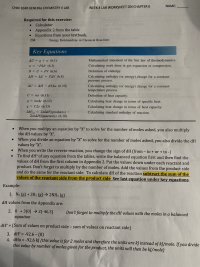
Chemistry
10th Edition
ISBN: 9781305957404
Author: Steven S. Zumdahl, Susan A. Zumdahl, Donald J. DeCoste
Publisher: Cengage Learning
expand_more
expand_more
format_list_bulleted
Question
Calculate the dHo of the synthesis reaction using the values from the table provided. H2(g) + O2 (g) ---> H2O (g)

Expert Solution
This question has been solved!
Explore an expertly crafted, step-by-step solution for a thorough understanding of key concepts.
This is a popular solution
Trending nowThis is a popular solution!
Step by stepSolved in 2 steps

Knowledge Booster
Learn more about
Need a deep-dive on the concept behind this application? Look no further. Learn more about this topic, chemistry and related others by exploring similar questions and additional content below.Similar questions
- Calculate K'p for the following reaction: 3CH3OH(g) 3CO(g) + 6H2(g)arrow_forwardAcetaldehyde (CH3CHO) is an important chemical both industrially and biologically. For instance, it is a (somewhat toxic) intermediate in the body's metabolism of ethanol into acetic acid, and thus is possibly implicated in the "hungover" symptoms of someone who has had too much to drink the night before. In aqueous solution, it establishes an equilibrium with a hydrated form, shown below. CH3CHO (aq) + H2O (l) <--> CH3CH(OH)2 (aq) You start with an aqueous sample, already at equilibrium, with the CH3CH(OH)2 (the hydrated form) at a concentration of 2.60 M. You have no information about how much, if any, of the anhydrous form (CH3CHO) is initially in the flask. If you add 2.0 M of CH3CHO to the reaction flask, and as the equilibrium is being restored the amount of CH3CH(OH)2 changes by 1.13 M, what is the final amount of CH3CHO?arrow_forwardin the reaction, how What a reaction shift (left or right) if we place the reaction a hot water bath(added heat)? What would the reaction color be after the shift?arrow_forward
- In the reaction: 2A ⇆ B + 3C For the reaction, ΔH = -23 kcal/mol and Keq = 26 X 10 -26 Is the reaction exothermic or endothermic? Are products or reactants favored? Using Le Chatelier’s Principle, what happens to the equilibrium if the concentration of C is increased? Using Le Chatelier’s Principle, what happens to the equilibrium if the concentration of A is increased?arrow_forwardComplete and balance the following reactions - assume they all go a. solid potassium carbonate plus heatb. solid ferric chlorate plus heatc. solid sodium chromate tetrahydrate plus heatarrow_forwardAt 100° C, the Keq for the Haber process is 4,51 x 10-5: N2 + 3 H2 ó 2 NH3 Consider the following reaction conditions and determine if the system is at equilibrium. If not, indicate the direction in which the reaction must proceed to establish equilibrium pNH3 = 105 atm, pN2 = 35 atm and pH2 = 495 atm pNH3 = 35 atm, pN2 = 0 atm and pH2 = 595 atm pNH3 = 26 atm, pN2 = 202 atm and pH2 = 42 atm pNH3 = 105 atm, pN2 = 5 atm and pH2 = 55 atmarrow_forward
arrow_back_ios
arrow_forward_ios
Recommended textbooks for you
 ChemistryChemistryISBN:9781305957404Author:Steven S. Zumdahl, Susan A. Zumdahl, Donald J. DeCostePublisher:Cengage Learning
ChemistryChemistryISBN:9781305957404Author:Steven S. Zumdahl, Susan A. Zumdahl, Donald J. DeCostePublisher:Cengage Learning ChemistryChemistryISBN:9781259911156Author:Raymond Chang Dr., Jason Overby ProfessorPublisher:McGraw-Hill Education
ChemistryChemistryISBN:9781259911156Author:Raymond Chang Dr., Jason Overby ProfessorPublisher:McGraw-Hill Education Principles of Instrumental AnalysisChemistryISBN:9781305577213Author:Douglas A. Skoog, F. James Holler, Stanley R. CrouchPublisher:Cengage Learning
Principles of Instrumental AnalysisChemistryISBN:9781305577213Author:Douglas A. Skoog, F. James Holler, Stanley R. CrouchPublisher:Cengage Learning Organic ChemistryChemistryISBN:9780078021558Author:Janice Gorzynski Smith Dr.Publisher:McGraw-Hill Education
Organic ChemistryChemistryISBN:9780078021558Author:Janice Gorzynski Smith Dr.Publisher:McGraw-Hill Education Chemistry: Principles and ReactionsChemistryISBN:9781305079373Author:William L. Masterton, Cecile N. HurleyPublisher:Cengage Learning
Chemistry: Principles and ReactionsChemistryISBN:9781305079373Author:William L. Masterton, Cecile N. HurleyPublisher:Cengage Learning Elementary Principles of Chemical Processes, Bind...ChemistryISBN:9781118431221Author:Richard M. Felder, Ronald W. Rousseau, Lisa G. BullardPublisher:WILEY
Elementary Principles of Chemical Processes, Bind...ChemistryISBN:9781118431221Author:Richard M. Felder, Ronald W. Rousseau, Lisa G. BullardPublisher:WILEY

Chemistry
Chemistry
ISBN:9781305957404
Author:Steven S. Zumdahl, Susan A. Zumdahl, Donald J. DeCoste
Publisher:Cengage Learning

Chemistry
Chemistry
ISBN:9781259911156
Author:Raymond Chang Dr., Jason Overby Professor
Publisher:McGraw-Hill Education

Principles of Instrumental Analysis
Chemistry
ISBN:9781305577213
Author:Douglas A. Skoog, F. James Holler, Stanley R. Crouch
Publisher:Cengage Learning

Organic Chemistry
Chemistry
ISBN:9780078021558
Author:Janice Gorzynski Smith Dr.
Publisher:McGraw-Hill Education

Chemistry: Principles and Reactions
Chemistry
ISBN:9781305079373
Author:William L. Masterton, Cecile N. Hurley
Publisher:Cengage Learning

Elementary Principles of Chemical Processes, Bind...
Chemistry
ISBN:9781118431221
Author:Richard M. Felder, Ronald W. Rousseau, Lisa G. Bullard
Publisher:WILEY